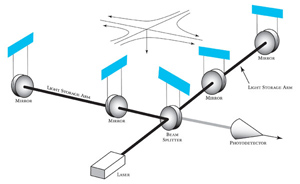 Above is a diagram of LIGO Detector. A LIGO staff installing a mode-matching mirror and supension into a vacuum chamber during the construction of LIGO.  |
At the APS April meeting in Philadelphia, PA, scientists from the collaboration reported on the first official results from LIGO's initial science run, conducted over 17 days in September 2002.
Gravitational waves are intriguing to astronomers as a tool for peering through clouds of gas and dust to see directly into the core of collapsing stars, deep into the heart of colliding galaxies, and back to the earliest moments of the universe.
They were first predicted by Albert Einstein in 1916 as a consequence of the general theory of relativity, but have yet to be detected directly. In Einstein's theory, alterations in the shape of concentrations of mass (or energy) have the effect of warping spacetime, thereby causing distortions that propagate through the universe at the speed of light.
Predictions about when the first-ever direct detection of gravitational waves will take place depend on how frequently strong bursts of waves bathe the Earth?something scientists do not yet know. LIGO leads a new generation of detectors coming into operation, promising sensitivities capable of detecting a variety of catastrophic events that produce gravitational waves.
With about 440 scientists, LIGO is as large as the many particle physics experiments underway at accelerators. LIGO has two controlling partners?MIT and Caltech?and is located in Washington state and Louisiana, and is also collaborating with other interferometer devices such as Germany's GEO and TAMA in Japan.
LIGO is essentially a giant strain gauge.
In the LIGO setup, laser light reflects repeatedly in each of two perpendicularly oriented 4-km-long pipes. A passing gravity wave will distort the local spacetime, stretching very slightly one of the paths while shrinking the other, causing the interference pattern of the two merging laser light beams to shift in a characteristic way.
LIGO does not measure static gravitational fields, such as those from the sun or Earth itself. Rather, it strives to see ripples in spacetime radiated by such events as the inspiral of two neutron stars toward each other, a phenomenon which would typically produce a strain in the LIGO apparatus as large as one part in 10 21.
That is, a passing gravity wave is expected to change the distance between mirrors some 4 km apart by about 10 -18 meters, a displacement 1000 times smaller than the size of a proton. Such a measurement represents a physics and engineering feat of great delicacy.
In the first run, no gravitational wave events were observed, but palpable knowledge was gained as to what the sky should look like when viewed in the form of gravity waves. So great is LIGO's sensitivity that it has been able to set the best upper limit on the output of gravitational waves from three of the four prime source categories: bursts from sources such as supernovas or gamma bursters; chirps from inspiraling objects such as coalescing binary stars; periodic signals, perhaps from sources like spherically asymmetric pulsars; and a stochastic background source arising from gravity waves orig- inating from the Big Bang itself.
LIGO Deputy Director Gary Sanders of Caltech said that in three of these four categories, the LIGO experiments had set new upper limits on the rate at which gravitational waves were being produced.
In the coalescing binary category, for example, LIGO has established an upper limit of 164 per year from the Milky Way, a factor of 26 better than the previous limit.
Erik Katsavounidis of MIT said that LIGO could establish an upper limit on periodic signals from bright pulsars with a sensitivity of about one part in 10 -22.
Realistically, scientists did no expect to detect gravitational waves at LIGO's present sensitivities. But Sheila Rowan (Stanford University and the University of Glasgow) reported that the instrument's second run is currently underway and expected to be ten times more sensitive than the first run. While LIGO's first run was sensitive to gravity waves from the Milky Way, the second, with its tenfold improvement in sensitivity, is expected to expand that range to about 15 million light years, a realm that include the nearby Andromeda galaxy.
Scientists anticipate that the new, improved instrument may detect gravitational waves on a daily basis, with signal strengths capable of revealing details of the waveforms to be read off and compared with theories of neutron stars, black holes, and other highly relativistic objects.
For more information on the LIGO collaboration, see http://www.ligo.caltech.edu.
©1995 - 2024, AMERICAN PHYSICAL SOCIETY
APS encourages the redistribution of the materials included in this newspaper provided that attribution to the source is noted and the materials are not truncated or changed.
Associate Editor: Jennifer Ouellette
June 2003 (Volume 12, Number 6)
Articles in this Issue

